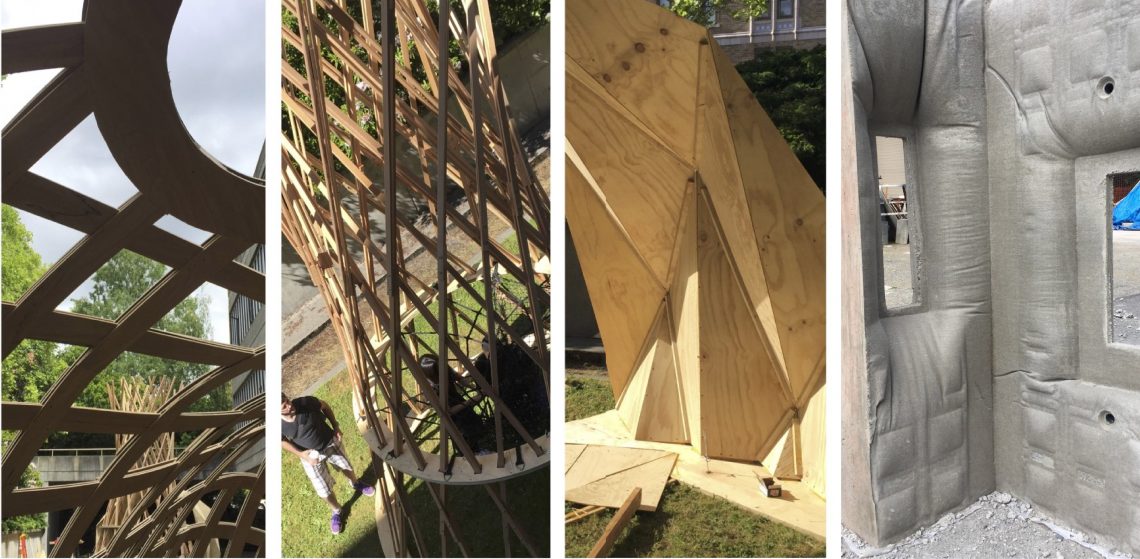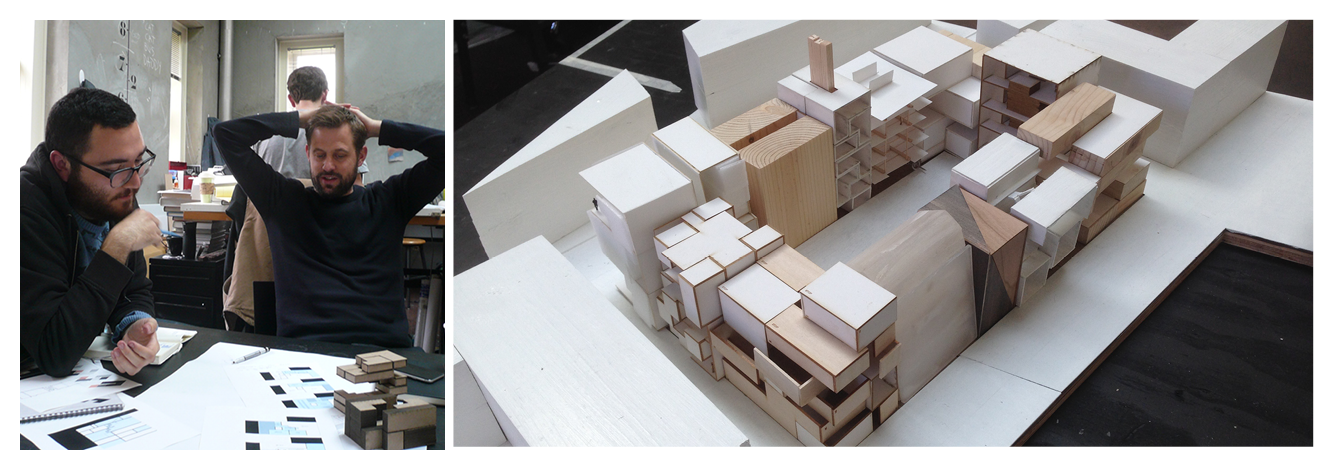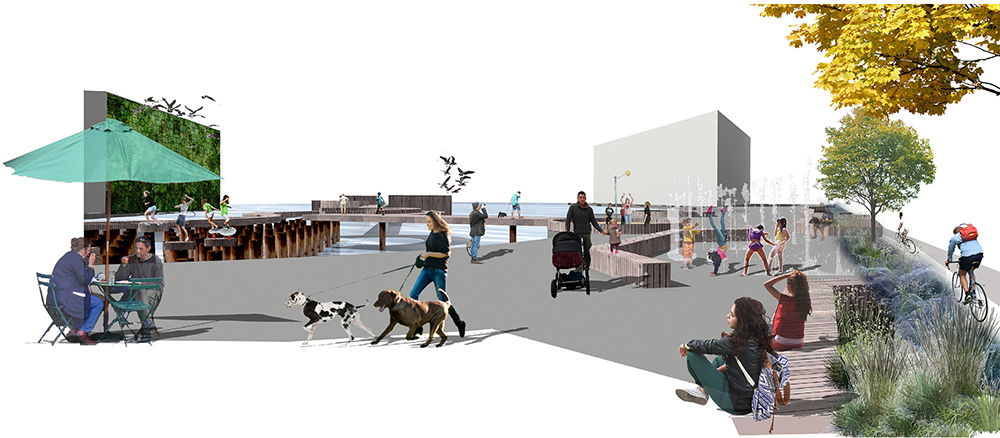The Department of Architecture offers specialized studios as a part of the curriculum at both the undergraduate and the graduate level. Typically, Furniture Studio is offered in the spring quarter for graduate students, and winter quarter for undergraduates. Storefront Studio is offered for undergraduates in spring quarter. Neighborhood Design/Build Studio is offered for both undergraduates and graduate students in the spring.
Recently, the department has created several new specialized studios, including the Scan Design Foundation Urban Design Master Studio, the Scan Design Foundation Distinguished Visiting Professor Master Architecture Studio, and the Barry Onouye Endowed Studio. In the past, projects from all of these studios have gained regional and national merit and recognition.
Furniture Studio
Each year, students have the opportunity to design and fabricate their own piece of furniture using the facilities located in the College of Built Environments. Students, many of whom have no furniture making experience, are able to learn how to craft and design their pieces using tools in our wood and metal labs, in addition to the laser cutters and CNC routers. Keeping in mind scale, costs, deadlines, and materials, students are expected to complete their furniture piece within the ten week quarter. The pace is quick, with students spending most of their free time outside of studio and on weekends in the shop making mock-ups, sanding, and sketching out ideas.
Interdisciplinary BE Studios
The College of Built Environments (CBE), has supported a number of interdisciplinary studios that have involved Architecture Department faculty. During the spring quarter of 2014 this program began with the first the McKinley Futures Studio, which is now offered annually. The studio is made possible by the Jeannette and David McKinley Endowment for the Design of Future Architectural Environments. Each year a new team of faculty create projects that will generate research-based, speculative design scenarios that will serve as a framework for closer examination of the great problems facing succeeding generations—society, health, environment, government, economy, science, and technology. The instructors for past studios have been: Daniel Friedman (CBE), 2014; Dave Miller (Architecture) and Ben Spencer (Landscape Architecture), 2015; and Gundula Proksch (Architecture) and Ken Yocom (Landscape Architecture), 2016.
Beginning in winter 2017 there will be a new series of CBE sponsored interdisciplinary studios offered each winter and fall that will explore a variety of issues related to the contemporary built environment. The inaugural studio will be on a theme of building reuse and involve Kathryn Merlino (Architecture) and Manish Chalana (Urban Design and Planning). The spring 2017 McKinley Futures Studio will be offered by Rick Mohler (Architecture) and Julie Parrett (Landscape Architecture).
Neighborhood Design/Build Studio
The Neighborhood Design/Build Studio is an award-winning studio offered by the Department of Architecture where students design and build small community projects for Seattle-area nonprofit groups. Architecture graduates and undergraduates in their final year gain experience with clients, public agencies, material and assembly details, and hands-on construction while working to benefit people in the greater community. The studio receives funding from the Department of Neighborhoods, local business community, and the Howard S. Wright Endowment fund.
For more information about the current Neighborhood Design/Build project and to see past projects, visit here.
Barry Onouye Endowed Studio
Thanks to the generosity of donor and CBE alumnus Malcolm Goodfellow, the Department of Architecture offers an annual design studio investigating the role of structure in architectural design under the tutelage of an invited structural engineer – The Barry Onouye Distinguished Chair in Architecture. The primary goal of the studio is for participants to uncover and embrace the integration of architecture and structure early in the design process. Past studios have focused on museums design, tall buildings, urban infrastructure, high-performance enclosures, timber shells, fabric-formed concrete, tensile structures and cedar wood. Some have included a significant design-build installation as a demonstration of structural concepts. The past recipients of the Onouye Distinguished Chair have been Jay Taylor (2012-2013), Joe Burns (2013-2014), Paolo Desideri (2014-2015), Maurya McClintock (2015-2016), John Ochsendorf (2016 – 2017), Mark West (2017-2018), Sigrid Adriaenssens (2018-2019) and Mitsuhiro Kanada (2019-2020).
Scan Design Foundation Master Architecture Studio
The Scan Design Foundation Distinguished Visiting Professor Program provides the Department of Architecture with the opportunity to bring distinguished Danish architects to Seattle each year to teach a master studio for graduate students. Typically this studio is structured around two intensive design charrettes occurring when the Visiting Professor is in Seattle. Visiting Professors have included Lene Tranberg (2011), Dorte Mandrup (2012 and 2013), Erling Christoffersen (2014), Dan Stubbergaard (2015), and Sinus Lynge and Tue Hesselberg Foged (2016).
Scan Design Foundation Urban Design Master Studio
The Scan Design Foundation Urban Design Master Studio combines international study experience with multi-disciplinary collaboration on urban design scale projects for the resilient public realm. Before the studio begins, students travel to Copenhagen, Denmark and Malmo, Sweden to study with leading Danish design offices in the fields of Urban Design, Landscape Architecture, Architecture and Environmental Urbanism. These include Gehl Architects, COBE and Third Nature as well as City architects and planners, examining the city through both people-centered and ecological urban design lenses.
For two weeks, students are immersed in the design and planning strategies that make Copenhagen one of the leading cities in climate resilience, public space, bicycle and pedestrian planning, and one of the “most livable” in the world. Upon return to UW, the studio focuses on applying lessons learned to sites based in Seattle or Copenhagen. The studio continues to benefit from the study tour throughout the quarter, with master teachers from Copenhagen design offices who travel to Seattle to extend Danish design concepts to students in the studio. The Scan Design Foundation generously supports this Master Studio and the travel-study experience.
Storefront Studio
The Storefront Studio is an outreach design studio, focusing on small towns in Washington State. It is offered as an undergraduate studio, the last in the sequence of studios, or as a vertical studio combined with graduate students. The focus of the studio is an investigation into the historic Main Streets of Washington State communities.
Student designs facilitate discussion on, and funding for, a mix of community-generated projects in architecture, landscape architecture, and urban design. Although individual programs and projects vary, every project enhances community resilience, inclusivity and authenticity, through historic preservation, economic revitalization, complete street/green street strategies, and enhanced public parks and infrastructures.
Each studio begins by meeting the community in the first of a series of town hall meetings, and open-house presentations. Day trips are complemented by digital research, and often include an overnight field trip. The studio starts as open-ended research by mapping local physical, social, and historical assets. The studio partners with the community to include its feedback as it designs enhancements for strategic community architecture and public space.
The studio designs and produces before and after images of the town’s assets. These tools are used to engage with community clients and gather public input on architectural, planning, public art, and landscape projects. Open houses provide local perspectives, and are a forum for sustained community interaction, enabling the studio to act as a civic catalyst.
Typically there are at least four community meetings:
1. Kick-off Meeting and Research
2. Asset Map and Preliminary Proposals
3. Proposed Strategic Enhancements
4. Final Revised Strategic Enhancements
Designs often lead to actual executed projects and installations. A studio book documents the process and the product, and is distributed in the community and on-line.
For more information about the studio, please visit the Storefront Studio website.





